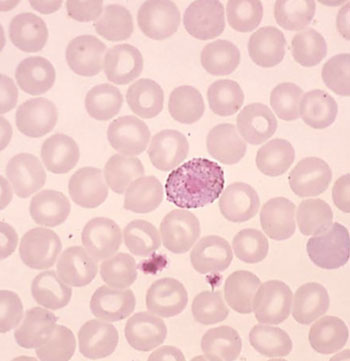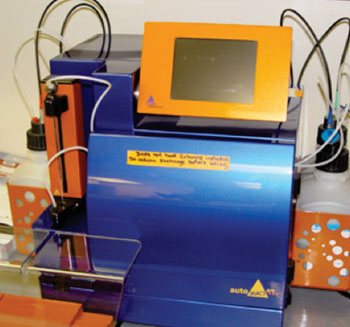Three Detection Methods Compared for Malaria Gametocytes
|
By LabMedica International staff writers Posted on 28 Aug 2014 |

Image: Blood smear showing a male gametocyte of Plasmodium vivax (Photo courtesy of Dr. Mae Melvin).

Image: Magnetic-activated cell sorting (MACS) equipment (Photo courtesy the University of South Carolina).
Gametocytes are the transmission stages of malaria parasites and as their density in the human host is typically low, they are often undetected by conventional light microscopy.
A detailed comparison of three methods, namely light microscopy, magnetic fractionation (MF) and reverse transcriptase polymerase chain reaction (RT-PCR) for detection of Plasmodium falciparum and P. vivax gametocytes has been conducted.
Scientists at the University of Western Australia (Fremantle, Australia) working with an international team took blood samples from total of 70 children, 56 with P. falciparum and 14 with P. vivax and aged between six months and five years. For the light microscopy Giemsa-stained thick blood smears were examined and parasite density quantified independently by two skilled microscopists with parasites counted against 500 white cells.
For the MF study the samples were subjected to high field gradient MF and magnetic particles (Spherotech; Lake Forest, IL, USA) were added to achieve a total known particle concentration of 100 particles per μL of blood. The samples were then magnetically fractionated using magnetic-activated cell sorting (MACS) equipment (Miltenyi Biotec; Bergisch Gladbach, Germany). For the RT-PCR study the team used the P. falciparum Pfs25 gene or the P. vivax Pvs25 gene copy number as a measure for gametocyte abundance. All RT-PCR assays were run in 384-well plate format on the LightCycler480 platform (Roche; Basel, Switzerland).
The scientists found that MF and RT-PCR were similarly sensitive and specific, and both were superior to light microscopy (LM). Overall, there were approximately 20% gametocyte-positive samples by LM, whereas gametocyte positivity by MF and RT-PCR were both more than two-fold this level. In the subset of samples collected prior to treatment, 29% of children were positive by LM, and 85% were gametocyte positive by MF and RT-PCR, respectively. MF is a feasible methodology for field-based gametocyte detection that can be applied even in larger scale studies. With an appropriate set- up, four to six samples could conveniently be processed by one person in an hour with results being available for all samples after approximately 90 minutes.
The authors concluded that that magnetic fractionation is a very good alternative method for on-site gametocyte detection under field conditions. The method has, as previously shown under laboratory conditions, similar sensitivity to RT-PCR and can be used to derive quantitative gametocyte densities for both P. falciparum and P. vivax. The study was published on August 14, 2014, in the Malaria Journal.
Related Links:
University of Western Australia
Spherotech
Miltenyi Biotec
A detailed comparison of three methods, namely light microscopy, magnetic fractionation (MF) and reverse transcriptase polymerase chain reaction (RT-PCR) for detection of Plasmodium falciparum and P. vivax gametocytes has been conducted.
Scientists at the University of Western Australia (Fremantle, Australia) working with an international team took blood samples from total of 70 children, 56 with P. falciparum and 14 with P. vivax and aged between six months and five years. For the light microscopy Giemsa-stained thick blood smears were examined and parasite density quantified independently by two skilled microscopists with parasites counted against 500 white cells.
For the MF study the samples were subjected to high field gradient MF and magnetic particles (Spherotech; Lake Forest, IL, USA) were added to achieve a total known particle concentration of 100 particles per μL of blood. The samples were then magnetically fractionated using magnetic-activated cell sorting (MACS) equipment (Miltenyi Biotec; Bergisch Gladbach, Germany). For the RT-PCR study the team used the P. falciparum Pfs25 gene or the P. vivax Pvs25 gene copy number as a measure for gametocyte abundance. All RT-PCR assays were run in 384-well plate format on the LightCycler480 platform (Roche; Basel, Switzerland).
The scientists found that MF and RT-PCR were similarly sensitive and specific, and both were superior to light microscopy (LM). Overall, there were approximately 20% gametocyte-positive samples by LM, whereas gametocyte positivity by MF and RT-PCR were both more than two-fold this level. In the subset of samples collected prior to treatment, 29% of children were positive by LM, and 85% were gametocyte positive by MF and RT-PCR, respectively. MF is a feasible methodology for field-based gametocyte detection that can be applied even in larger scale studies. With an appropriate set- up, four to six samples could conveniently be processed by one person in an hour with results being available for all samples after approximately 90 minutes.
The authors concluded that that magnetic fractionation is a very good alternative method for on-site gametocyte detection under field conditions. The method has, as previously shown under laboratory conditions, similar sensitivity to RT-PCR and can be used to derive quantitative gametocyte densities for both P. falciparum and P. vivax. The study was published on August 14, 2014, in the Malaria Journal.
Related Links:
University of Western Australia
Spherotech
Miltenyi Biotec
Latest Microbiology News
- Handheld Device Delivers Low-Cost TB Results in Less Than One Hour
- New AI-Based Method Improves Diagnosis of Drug-Resistant Infections
- Breakthrough Diagnostic Technology Identifies Bacterial Infections with Almost 100% Accuracy within Three Hours
- Innovative ID/AST System to Help Diagnose Infectious Diseases and Combat AMR
- Gastrointestinal Panel Delivers Rapid Detection of Five Common Bacterial Pathogens for Outpatient Use
- Rapid PCR Testing in ICU Improves Antibiotic Stewardship
- Unique Genetic Signature Predicts Drug Resistance in Bacteria
- Unique Barcoding System Tracks Pneumonia-Causing Bacteria as They Infect Blood Stream
- Rapid Sepsis Diagnostic Test Demonstrates Improved Patient Care and Cost Savings in Hospital Application
- Rapid Diagnostic System to Detect Neonatal Sepsis Within Hours
- Novel Test to Diagnose Bacterial Pneumonia Directly from Whole Blood
- Interferon-γ Release Assay Effective in Patients with COPD Complicated with Pulmonary Tuberculosis
- New Point of Care Tests to Help Reduce Overuse of Antibiotics
- 30-Minute Sepsis Test Differentiates Bacterial Infections, Viral Infections, and Noninfectious Disease
- CRISPR-TB Blood Test to Enable Early Disease Diagnosis and Public Screening
- Syndromic Panel Provides Fast Answers for Outpatient Diagnosis of Gastrointestinal Conditions
Channels
Clinical Chemistry
view channel
‘Brilliantly Luminous’ Nanoscale Chemical Tool to Improve Disease Detection
Thousands of commercially available glowing molecules known as fluorophores are commonly used in medical imaging, disease detection, biomarker tagging, and chemical analysis. They are also integral in... Read more
Low-Cost Portable Screening Test to Transform Kidney Disease Detection
Millions of individuals suffer from kidney disease, which often remains undiagnosed until it has reached a critical stage. This silent epidemic not only diminishes the quality of life for those affected... Read more
New Method Uses Pulsed Infrared Light to Find Cancer's 'Fingerprints' In Blood Plasma
Cancer diagnoses have traditionally relied on invasive or time-consuming procedures like tissue biopsies. Now, new research published in ACS Central Science introduces a method that utilizes pulsed infrared... Read moreMolecular Diagnostics
view channel
Blood Biomarker Test Could Detect Genetic Predisposition to Alzheimer’s
New medications for Alzheimer’s disease, the most common form of dementia, are now becoming available. These treatments, known as “amyloid antibodies,” work by promoting the removal of small deposits from... Read more
Novel Autoantibody Against DAGLA Discovered in Cerebellitis
Autoimmune cerebellar ataxias are strongly disabling disorders characterized by an impaired ability to coordinate muscle movement. Cerebellar autoantibodies serve as useful biomarkers to support rapid... Read more
Gene-Based Blood Test Accurately Predicts Tumor Recurrence of Advanced Skin Cancer
Melanoma, an aggressive form of skin cancer, becomes extremely difficult to treat once it spreads to other parts of the body. For patients with metastatic melanoma tumors that cannot be surgically removed... Read moreHematology
view channel
New Scoring System Predicts Risk of Developing Cancer from Common Blood Disorder
Clonal cytopenia of undetermined significance (CCUS) is a blood disorder commonly found in older adults, characterized by mutations in blood cells and a low blood count, but without any obvious cause or... Read more
Non-Invasive Prenatal Test for Fetal RhD Status Demonstrates 100% Accuracy
In the United States, approximately 15% of pregnant individuals are RhD-negative. However, in about 40% of these cases, the fetus is also RhD-negative, making the administration of RhoGAM unnecessary.... Read moreImmunology
view channel
Stem Cell Test Predicts Treatment Outcome for Patients with Platinum-Resistant Ovarian Cancer
Epithelial ovarian cancer frequently responds to chemotherapy initially, but eventually, the tumor develops resistance to the therapy, leading to regrowth. This resistance is partially due to the activation... Read more
Machine Learning-Enabled Blood Test Predicts Immunotherapy Response in Lymphoma Patients
Chimeric antigen receptor (CAR) T-cell therapy has emerged as one of the most promising recent developments in the treatment of blood cancers. However, over half of non-Hodgkin lymphoma (NHL) patients... Read morePathology
view channel
Novel UV and Machine Learning-Aided Method Detects Microbial Contamination in Cell Cultures
Cell therapy holds great potential in treating diseases such as cancers, inflammatory conditions, and chronic degenerative disorders by manipulating or replacing cells to restore function or combat disease.... Read more
New Error-Corrected Method to Help Detect Cancer from Blood Samples Alone
"Liquid biopsy" technology, which relies on blood tests for early cancer detection and monitoring cancer burden in patients, has the potential to transform cancer care. However, detecting the mutational... Read more
"Metal Detector" Algorithm Hunts Down Vulnerable Tumors
Scientists have developed an algorithm capable of functioning as a "metal detector" to identify vulnerable tumors, marking a significant advancement in personalized cancer treatment. This breakthrough... Read more
Novel Technique Uses ‘Sugar’ Signatures to Identify and Classify Pancreatic Cancer Cell Subtypes
Pancreatic cancer is often asymptomatic in its early stages, making it difficult to detect until it has progressed. Consequently, only 15% of pancreatic cancers are diagnosed early enough to allow for... Read moreTechnology
view channel
Pain-On-A-Chip Microfluidic Device Determines Types of Chronic Pain from Blood Samples
Chronic pain is a widespread condition that remains difficult to manage, and existing clinical methods for its treatment rely largely on self-reporting, which can be subjective and especially problematic... Read more
Innovative, Label-Free Ratiometric Fluorosensor Enables More Sensitive Viral RNA Detection
Viruses present a major global health risk, as demonstrated by recent pandemics, making early detection and identification essential for preventing new outbreaks. While traditional detection methods are... Read moreIndustry
view channel
Cepheid and Oxford Nanopore Technologies Partner on Advancing Automated Sequencing-Based Solutions
Cepheid (Sunnyvale, CA, USA), a leading molecular diagnostics company, and Oxford Nanopore Technologies (Oxford, UK), the company behind a new generation of sequencing-based molecular analysis technologies,... Read more
Grifols and Tecan’s IBL Collaborate on Advanced Biomarker Panels
Grifols (Barcelona, Spain), one of the world’s leading producers of plasma-derived medicines and innovative diagnostic solutions, is expanding its offer in clinical diagnostics through a strategic partnership... Read more




















